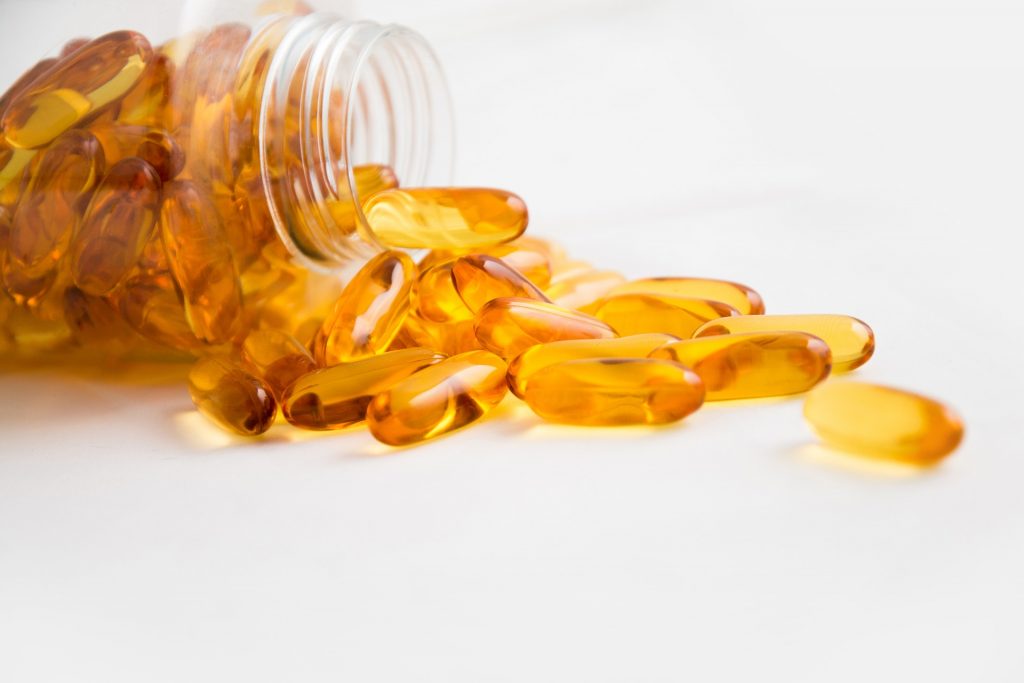 Vitamin E is available in both a natural and synthetic form. The natural form is derived from plants, and is synthesised precisely by metabolic pathways containing specific enzymes. This creates a form of alpha tocopherol designated as RRR-α-tocopherol. Vitamin E can also be synthesised in the laboratory using chemical processes, and this is less precise. The resulting synthetic vitamin E is designated as all-rac-α-tocopherol, representing the fact that it is a mixture of stereoisomers of alpha tocopherol, some of which are not recognised by mammalian biochemistry. As a result of the natural vitamin E containing only isomers that are bioavailable, the natural form of alpha tocopherol (RRR-α-tocopherol) has a relatively higher bioavailability compared to the synthetic form. Studies have shown that all-rac-α-tocopherol can meet vitamin E requirements of healthy individuals, but that corrections must be made for the lower bioavailability of this form of the vitamin E.
Vitamin E is available in both a natural and synthetic form. The natural form is derived from plants, and is synthesised precisely by metabolic pathways containing specific enzymes. This creates a form of alpha tocopherol designated as RRR-α-tocopherol. Vitamin E can also be synthesised in the laboratory using chemical processes, and this is less precise. The resulting synthetic vitamin E is designated as all-rac-α-tocopherol, representing the fact that it is a mixture of stereoisomers of alpha tocopherol, some of which are not recognised by mammalian biochemistry. As a result of the natural vitamin E containing only isomers that are bioavailable, the natural form of alpha tocopherol (RRR-α-tocopherol) has a relatively higher bioavailability compared to the synthetic form. Studies have shown that all-rac-α-tocopherol can meet vitamin E requirements of healthy individuals, but that corrections must be made for the lower bioavailability of this form of the vitamin E.

Synthetic vitamin E may interfere in some ways with normal alpha tocopherol metabolism. This was illustrated in this study by the fact that synthetic vitamin E users had depressed levels of alpha tocopherol in their blood compared to both non-supplement users and low dose natural vitamin E supplement users. Only relatively higher intakes of supplemental vitamin E in its natural form could overcome this depression in blood levels.
For example, in one study, researchers analysed previous nutritional study data collected from the population in Ireland. Using the equivalence ratio of 1 mg of all-rac-α-tocopherol being equivalent to 1.36 mg of RRR-α-tocopherol, they analysed the number of subjects that managed to obtain the European Union recommended intake of 12 mg of alpha tocopherol per day from the diet (and supplements). All of the participants analysed managed to obtain the 12 mg figure. In further analysis, the researcher observed that in all-rac-α-tocopherol supplement users consuming more than 11 mg per day from supplements, the plasma concentrations of RRR-α-tocopherol were significantly lower than those who did not use supplements or who consumes RRR-α-tocopherol supplements of greater than 35 mg per day. Those who consumed RRR-α-tocopherol supplements had significantly higher plasma α-tocopherol compared to all-rac-α-tocopherol supplement users.
Dr Robert Barrington’s Comments: This suggests that natural form vitamin E is superior to synthetic vitamin E and that synthetic vitamin E may actually detrimentally affect vitamin E status. Just because 12 mg is the recommended intake does not mean it is the optimal intake. Do your own research and do not take governmental recommendations as gospel.
Eat Well, Stay Healthy, Protect Yourself
RdB
